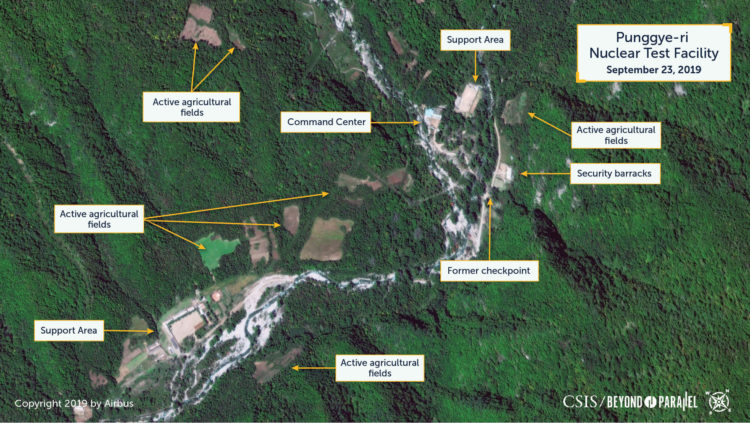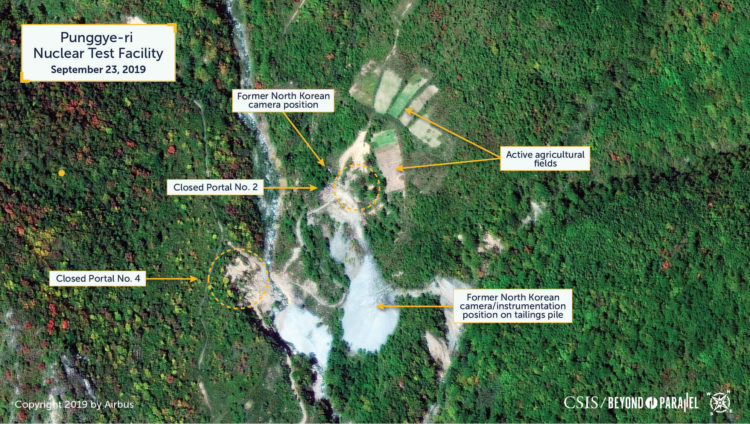
Punggye-ri Nuclear Test Site: Imagery Supports ROK and U.S. Government Reservations about Permanent Disablement
Analysis
Analysis of satellite imagery of the Punggye-ri Nuclear Test Facility acquired during 2019 and more specifically on September 23rd and October 9th, 2019 shows the facility in caretaker status, likely being maintained by security personnel. While there is no evidence of current efforts to restore any of the nuclear test portals, several observations lead us to believe the facility has not been permanently disabled and that the detonations in May 2018 are not necessarily irreversible.
- The two images below show the continued presence of actively maintained agricultural fields around the central Command Center area and support areas located southwest of the main administrative area and nuclear test tunnels/portals.


- Slightly south of the Command Center area is another active support facility and agricultural fields. This is indicated by the generally neat and well-maintained appearance of the facility and the presence of either a recently tilled garden plot or piles of dried grain.

- Another image shows a nearby agricultural support facility located slightly northeast of the Central Command area is also being actively maintained.

- Located northeast of the Command Center area is the main administrative area, which is partially razed. However, surrounding agricultural fields remain active.



Taken together with the significant and ongoing international doubts over the actual results of North Korea’s 2018 public demolition exercise, the continued observations that the Punggye-ri Nuclear Test Facility is being actively maintained supports recent public statements by JCS Chairman Park Han-ki and a recent Department of State report about the potential reversibility of North Korea disable efforts in May 2018.
Background
During a question-and-answer session of a parliamentary audit by South Korea’s National Assembly’s National Defense Committee at the Joint Chiefs of Staff (JCS) building on October 8, 2019, Joint Chiefs of Staff Chairman Park Han-Ki assessed that the Punggye-ri Nuclear Test Facility in Kilju-gun (County), North Hamgyong Province, which North Korea partially demolished in May last year, could return to operational status after some restoration work.
He commented on behalf of the JCS and South Korean military authorities, “…we estimate that tunnels (in Punggye-ri) can be restored after some restoration work,” and that “although Tunnels No. 1 and No. 2 are difficult (to restore), Tunnels No. 3 and No. 4 could be reused after repair, under the right circumstances.”1 Regarding the restoration work, he then explained, “we believe that the restoration work will take at least several weeks to complete (for the tunnels to be used again).”2
This assessment follows one issued by the U.S. Department of State in its August 2019 report Adherence to and Compliance with Arms Control, Nonproliferation, and Disarmament Agreements and Commitments.3 This report states “It is assessed that the results of the detonations at P’unggye Nuclear Test Site on May 24, 2018, are almost certainly reversible. It is possible that North Korea could develop another nuclear test site, if it chose to do so.”4
Asked by Baek Seung-Joo of the main opposition Liberty Korea Party about whether North Korea is producing nuclear materials and nuclear weapons, Park replied, “North Korea is continuing nuclear research activities as well as missile research activities.” Asked by Baek whether North Korean nuclear activities and missile development should be considered hostile acts, Park stressed the importance of defining a hostile act, stating that “…hostile acts are defined as direct attacks or the use of force.”5
When asked whether North Korea’s Pukguksong-3 submarine-launched ballistic missile (SLBM) is a three-stage missile, Chairman Park stated that “…we assess the Pukguksong-3 to be a two-stage missile”, adding that “…though there has been claims that the separation of the warhead suggest a three-stage missile, it is difficult to see the separation of the warhead as a stage separation.”6 Along the same subject, Park added that “stage separation occurred only once at the first stage separation (when the Pukguksong-3 was launched), and the final stage of the warhead flying cannot be seen as a stage separation.”7
Asked whether the range of North Korea’s SLBMs has increased by 50 percent due to fuel, Park said, …“we believe that the thrust has increased by that much due to using solid fuel, and the solid fuel propellant system may have also been upgraded.” As for the possibility of North Korea launching additional SLBMs, he said, “we’re currently tracking that possibility in many ways.”8
Director of the South Korean Defense Intelligence Agency corroborated Chairman Park’s statements regarding the reversibility of Punggye-ri’s operational status, stating that “we assess that it is possible for the tunnels to be restored after some restoration work,” and that “experts suggest that the tunnels can be restored after some restoration work, though no moves for restoration have been detected.”9
References
- Chul-Jae Lee, Ji-Hyae Yoo, and Geun-Pyeong Lee, “Nuclear test possible in Punggye-ri if tunnels No. 3 and 4 are restored, JoongAng Ilbo, October 9, 2019, https://news.joins.com/article/23598937. ↩
- Gwee-Geun Kim and Joon-Sam Lee, “N. Korea able to use Punggye-ri nuke testing site after restoration work: JCS,” Yonhap News, October 8, 2019, https://www.yna.co.kr/view/AKR20191008147151504. ↩
- Adherence to and Compliance with Arms Control, Nonproliferation, and Disarmament Agreements and Commitments (Washington, D.C.: U.S. Department of State, April 2019), p. 27, https://www.state.gov/wp-content/uploads/2019/08/Compliance-Report-2019-August-19-Unclassified-Final.pdf. ↩
- Yonhap News, October 8, 2019. ↩
- Ibid. ↩
- Ibid. ↩
- Ibid. ↩
- Ibid. ↩
- Ibid. ↩

